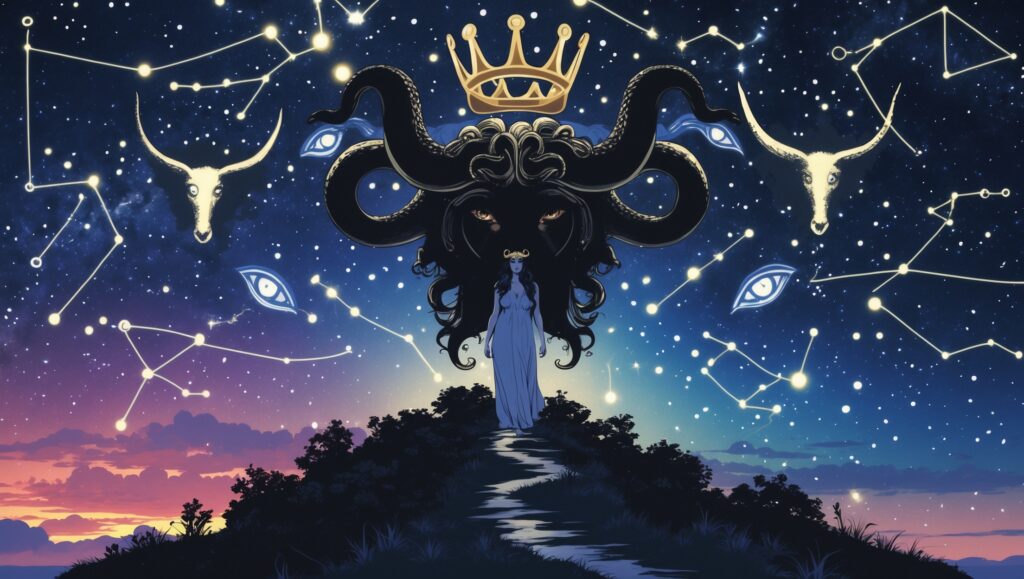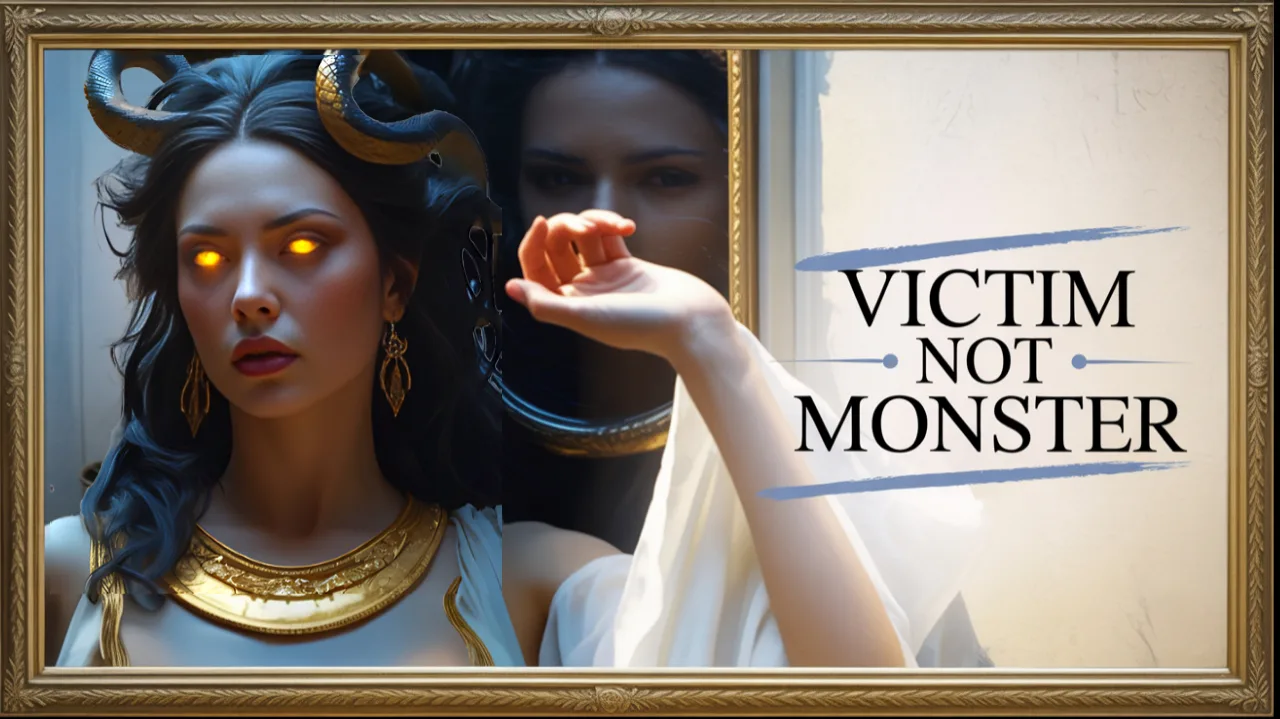Introduction: Beyond the Stone Gaze
When you hear the name Medusa, what comes to mind? A terrifying monster? A snake-haired creature who turns people to stone with a single glance? A villain defeated by the hero Perseus? If so, you’re not alone. For centuries, Medusa has been one of the most feared and misunderstood figures in Greek mythology — a symbol of horror and danger.
But what if I told you there’s a different side to Medusa? A story hidden beneath layers of myth and fear — one of beauty, betrayal, injustice, and tragedy? What if Medusa isn’t just a monster, but a tragic heroine whose tale speaks to victims, survivors, and anyone who’s ever been unfairly judged?
Let’s step into the shadows and uncover the untold story of Medusa.
The Beautiful Priestess

Long before snakes writhed in her hair and her gaze petrified all who looked upon her, Medusa was a young woman of extraordinary beauty. She wasn’t a monster; she was a mortal — a priestess dedicated to Athena, goddess of wisdom and war.
Picture this: Medusa, with flowing dark hair and radiant skin, serving in the sacred temple. She had taken a vow of chastity, dedicating her life to Athena’s service. Her beauty was celebrated, but it was also her curse.
One day, Poseidon — the powerful and unpredictable god of the sea — noticed Medusa. Drawn by her allure, he violated her within the temple of Athena itself. This act was not only a grave offense to Medusa but also a desecration of Athena’s sacred space.
The Wrath of Athena

Now, this is where the story takes a tragic turn. Rather than punishing Poseidon — a mighty god whom even Athena dared not anger — Athena’s fury was directed at Medusa.
In a cruel twist, Athena cursed Medusa. Her once-beautiful hair was transformed into writhing snakes, and her eyes were given the terrible power to turn anyone who met her gaze to stone. Medusa was condemned to live in isolation, feared by all.
Imagine the horror: a woman violated and then punished by the very goddess she worshipped. Medusa became a living nightmare, a symbol of fear and revulsion.
The Monster’s Lair

Medusa fled to a remote island, far from human society. Her new form was terrifying — snakes hissed where once there was soft hair, and her gaze was deadly.
People whispered stories of the Gorgon, a monster who lurked in the shadows, turning travelers to stone. But they never heard Medusa’s side. They only saw the curse.
She was no longer the priestess; she was a monster in the eyes of the world — alone, misunderstood, and trapped by a divine punishment she didn’t deserve.
The Hero’s Quest

The tale most are familiar with is Perseus’s quest to slay Medusa. King Polydectes, seeking to rid himself of Perseus, sent the young hero on an impossible mission: to bring back the head of the monster Medusa.
Armed with gifts from the gods — Athena’s reflective shield, Hermes’s winged sandals, Hades’s helmet of invisibility, and a magical sickle — Perseus set out.
Using the shield as a mirror to avoid Medusa’s deadly gaze, Perseus approached her while she slept. In one swift motion, he beheaded her.
The Power in Death
Though Medusa was dead, her power did not vanish. Her severed head retained the petrifying gaze, becoming a weapon Perseus used to defeat enemies. Eventually, Athena placed Medusa’s head on her shield, the Aegis, turning it into a symbol of protection.
Thus, Medusa’s legacy lived on — but as a weapon, not a person. Her story was reduced to a cautionary tale of heroism, with little acknowledgment of her tragic past.
Chapter 6: Medusa Through the Ages — From Horror to Heroine

For centuries, artists, poets, and storytellers portrayed Medusa as a monstrous villain, the embodiment of terror and chaos. But over time, a different interpretation began to emerge.
Feminist scholars, writers, and artists started to reclaim Medusa’s story, highlighting the injustice of her punishment and portraying her as a victim rather than a villain.
Medusa became a symbol of female rage, survival, and empowerment. Her transformation from beautiful woman to feared Gorgon mirrored the societal punishment of women’s anger and autonomy.
Medusa as a Symbol of Trauma and Resilience
Medusa’s story resonates deeply with anyone who has experienced trauma or injustice. She is the archetype of a survivor punished for being a victim.
Psychologists see her snake-haired visage as a metaphor for trauma’s lasting impact — a visible mark that isolates and alienates. Yet, her power to turn men to stone can be seen as a defensive mechanism, a way to protect herself from further harm.
Medusa in Modern Culture
Today, Medusa appears everywhere — in literature, art, fashion, and even social justice movements. She’s featured in novels that tell her story from her perspective, showing her humanity and pain.
Artists depict her not as a monster but as a tragic figure of strength. Her image is embraced as a symbol of female empowerment, resistance, and survival.
What Medusa Teaches Us Today
Medusa’s myth challenges us to reconsider how we judge others, especially victims. It calls out the injustice of blaming victims for their suffering and warns against the dangers of fear and misunderstanding.
Her story reminds us to look beyond surface appearances and see the humanity beneath.
Conclusion: The Legacy of Medusa — Monster or Heroine?
Medusa’s story is far more than a myth about a monster. It is a complex tale of beauty, betrayal, injustice, and ultimately, empowerment.
She teaches us that sometimes the monsters we fear are just victims in disguise — and that through resilience and courage, even the most cursed can become heroes in their own right.
If you take away one thing from Medusa’s story, let it be this: behind every myth lies a deeper truth — one that calls for empathy, understanding, and justice.
For more mythological stories visit https://www.youtube.com/@Mythoexplorers
To know interesting Hindu mythology facts visit https://mythfacts.blog/category/hindu-mythology/
To know interesting Norse mythology facts visit https://mythfacts.blog/category/norse-mythology/
To know interesting Egyptian mythology facts visit https://mythfacts.blog/category/egyptian-mythology/

